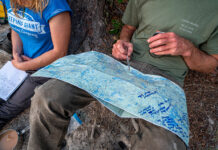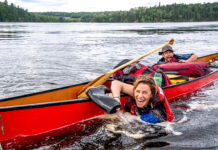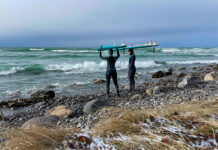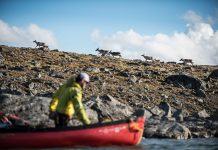Did you know there’s a portable hot tub you can take camping?
It sounds nice, doesn’t it? Steamy baths under a night sky. The price might be enough to put those fantasies on ice though—$600 – $999.
If that doesn’t dissuade you, have a look at the specs. The unit weighs 20 pounds. Certainly not for the lightweight paddler, but an equal weight of food (or beer) has been paddled into the woods before. On closer inspection of the fine print, those 20 pounds aren’t representative of the total weight—you’ll need to schlep another 30 pounds to bring in the tub’s external heating unit. Otherwise you might as well just sit in the lake.
Even if the price and the weight doesn’t make you balk—maybe it’s an indulgence for car campers or ATVers—you’ll still have to fill up the tub. All 225 gallons of it. That’s potentially 851 trips with a one-liter pot—to the lake, to the spigot or more likely, to the backyard hose, because this tub isn’t likely to make it farther than your driveway.
While the backcountry hot tub might seem to be one of the more impractical camping inventions on offer, it’s surely not the only eyebrow raiser out there. There are 16-room tents, tent-specific air-conditioning units and plush, 20-pound queen-sized cots. There are pop-up kitchens with more storage than my brick-and-motor pantry, inflatable outdoor loveseats and tents with electricity. Also: portable dishwashers, collapsible whisks and a Swiss Army knife with 80 implements.
All quality products, and all products I’ve probably momentarily wished I had at some point in the past. But there’s something that doesn’t sit right about trying to replicate all the modern conveniences my house offers—and even some it doesn’t— in the wilderness.
Last fall I had the privilege to spend a week in the boreal forest with Ray Mears and got a first hand look at a master of bushcraft in action. It helped me gain some perspective—what am I doing with all these things?
In the Canoeroots office it can be easy to get a little gear-obsessed—manufacturer specs noting the ounces saved, R-values and durable denier weaves dance across my desk. A sleeping bag that packs down smaller than a Dutch oven that weighs less than a titanium spork and promises to keep me as warm as Thomas’ red snowsuit? Wow!
It’s super cool—but it’s still just stuff.
While I’ve drooled over weather-proof mini torches, perfect for lighting a fire in any conditions, there was something much more meaningful—primitive, ethereal—in seeing Mears create fire from friction using only materials available in the forest.
It got me thinking about getting back to the basics. The only items absolutely essential for exploring the wilderness are a canoe, paddle and PFD. I’m going to start rebuilding my camp kit from there—no hot tubs needed.
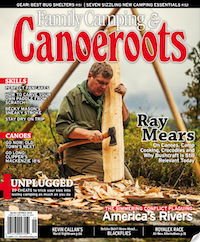 This article first appeared in the Spring 2015 issue of Canoeroots and Family Camping magazine.
This article first appeared in the Spring 2015 issue of Canoeroots and Family Camping magazine.
Subscribe to Paddling Magazine and get 25 years of digital magazine archives including our legacy titles: Rapid, Adventure Kayak and Canoeroots.



